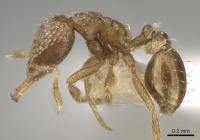Strumigenys stygia
| Strumigenys stygia | |
|---|---|

| |
| Scientific classification | |
| Kingdom: | Animalia |
| Phylum: | Arthropoda |
| Class: | Insecta |
| Order: | Hymenoptera |
| Family: | Formicidae |
| Subfamily: | Myrmicinae |
| Tribe: | Attini |
| Genus: | Strumigenys |
| Species: | S. stygia |
| Binomial name | |
| Strumigenys stygia Santschi, 1913 | |
Known from two collections, neither of which included any biological details.
Identification
A member of the arnoldi complex in the Strumigenys arnoldi-group.
Bolton (1983) - S. stygia is similar to Strumigenys arnoldi, Strumigenys traegaordhi, Strumigenys mesahyla and Strumigenys nimbrata. These four are separated from stygia as arnoldi lacks pronotal flagellate hairs, nimbrata has funicular segments 2 and 3 vestigial, and both mesahyla and traegaordhi do not have the postpetiole sculptured.
Keys including this Species
Distribution
Distribution based on Regional Taxon Lists
Afrotropical Region: Angola, Cameroun, Kenya (type locality), Zimbabwe, Zimbabwe.
Distribution based on AntMaps
Distribution based on AntWeb specimens
Check data from AntWeb
Countries Occupied
| Number of countries occupied by this species based on AntWiki Regional Taxon Lists. In general, fewer countries occupied indicates a narrower range, while more countries indicates a more widespread species. |

|
Estimated Abundance
| Relative abundance based on number of AntMaps records per species (this species within the purple bar). Fewer records (to the left) indicates a less abundant/encountered species while more records (to the right) indicates more abundant/encountered species. |

|
Biology
Castes
Nomenclature
The following information is derived from Barry Bolton's Online Catalogue of the Ants of the World.
- stygia. Strumigenys (Strumigenys) stygia Santschi, 1913b: 257 (diagnosis in key) (w.) KENYA. Santschi, 1914b: 113 (w.). See also: Brown, 1954k: 29; Bolton, 1983: 394; Bolton, 2000: 596.
Unless otherwise noted the text for the remainder of this section is reported from the publication that includes the original description.
Description
Worker
Bolton (1983) - TL 1.9-2.1, HL 0.50-0.53, HW 0.40-0.43, CI 80-84, ML 0.18-0.21, MI 36-40, SL 0.26-0.28, SI 63-68, PW 0.24-0.25, AL 0.48-0.52 (7 measured).
Apical fork of each mandible with 2 teeth, without intercalary teeth or denticles. Each mandibular blade with 2 pre apical teeth, the proximal longer than the distal in each case. Upper scrobe margins convex, the eyes not visible in full-face view. Eyes small, the maximum diameter distinctly less than the maximum width of the scape. Preocular notch absent, ventral surface of head without a transverse preocular groove or impression. Antennal scapes curved in the basal third, the median third expanded and somewhat flattened, the convex leading edges of the scapes with a row of apically curved short broadly spoon-shaped hairs. Ground-pilosity of head relatively broad spoon-shaped hairs which are curved anteriorly and appear stud-like or scale-like in full-face view, the hairs on the dorsum anterior to the highest point of the vertex somewhat larger and more conspicuous than those posterior to this point. Hairs fringing the upper scrobe margins the same shape as those on the dorsum. Cephalic dorsum reticulate-punctate. Pronotal humeri each with a single fine flagellate hair. Mesonotum with a single pair of clavate standing hairs. Ground pilosity of dorsal alitrunk of sparse spoon-shaped to scale-like small hairs. Mesonotum depressed behind the level of the pair of hairs. Metanotal groove represented on the dorsum by a faint line. Sides of pronotum superficially reticulate or granular, pleurae and propodeum laterally smooth except for some weak patches of punctate sculpture peripherally. Pronotal dorsum densely punctate, usually with overlying weak longitudinal rugulae. Remainder of dorsal alitrunk reticulate-punctate. Dorsum of petiole node reticulate-punctate, postpetiole superficially granular to reticulate-punctate. Ventral spongiform strip of petiole narrow and inconspicuous. Ventral spongiform lobe of postpetiole equal to or slightly less than the exposed area of the postpetiole. Basigastral costulae conspicuous. Dorsal surfaces of petiole, postpetiole and gaster with stout standing hairs which are thickened or clavate apically. Colour light brown to medium brown.
Type Material
Bolton (1983) - Syntype workers, KENYA: Cave A at Shimoni, st. no. 9, xi.1911 (Alluaud &feannel) (Naturhistorisches Museum, Basel) [examined].
References
- Bolton, B. 1983. The Afrotropical dacetine ants (Formicidae). Bulletin of the British Museum (Natural History). Entomology. 46:267-416. (page 394, redescription of worker)
- Bolton, B. 2000. The ant tribe Dacetini. Memoirs of the American Entomological Institute. 65:1-1028. (page 596, redescription of worker)
- Brown, W. L., Jr. 1954k. The ant genus Strumigenys Fred. Smith in the Ethiopian and Malagasy regions. Bulletin of the Museum of Comparative Zoology 112: 1-34 (page 29, redescription of worker)
- Santschi, F. 1913b. Clé analytique des fourmis africaines du genre Strumigenys Sm. (Hym.). Bull. Soc. Entomol. Fr. 1913: 257-259 (page 257, worker described)
- Santschi, F. 1914b. Voyage de Ch. Alluaud et R. Jeannel en Afrique Orientale, 1911-1912. Résultats scientifiques. Insectes Hyménoptères. II. Formicidae. Paris: Libr. A. Schulz, pp. 41-148. (page 113, description of worker)
References based on Global Ant Biodiversity Informatics
- Bolton B. 1983. The Afrotropical dacetine ants (Formicidae). Bulletin of the British Museum (Natural History). Entomology 46: 267-416.
- Brown W. L. Jr. 1954. The ant genus Strumigenys Fred. Smith in the Ethiopian and Malagasy regions. Bulletin of the Museum of Comparative Zoology 112: 1-34.
- Wheeler W. M. 1922. Ants of the American Museum Congo expedition. A contribution to the myrmecology of Africa. VIII. A synonymic list of the ants of the Ethiopian region. Bulletin of the American Museum of Natural History 45: 711-1004

